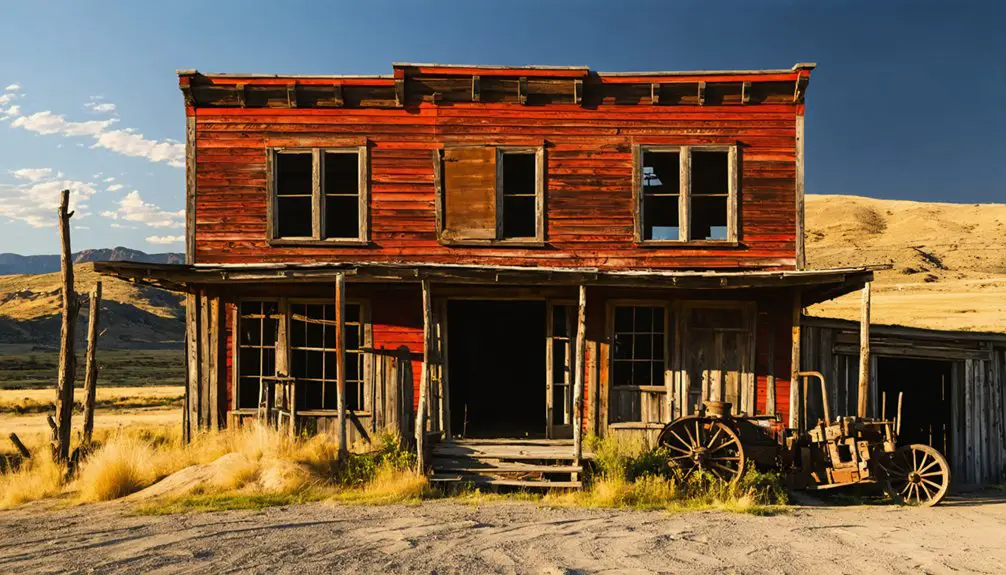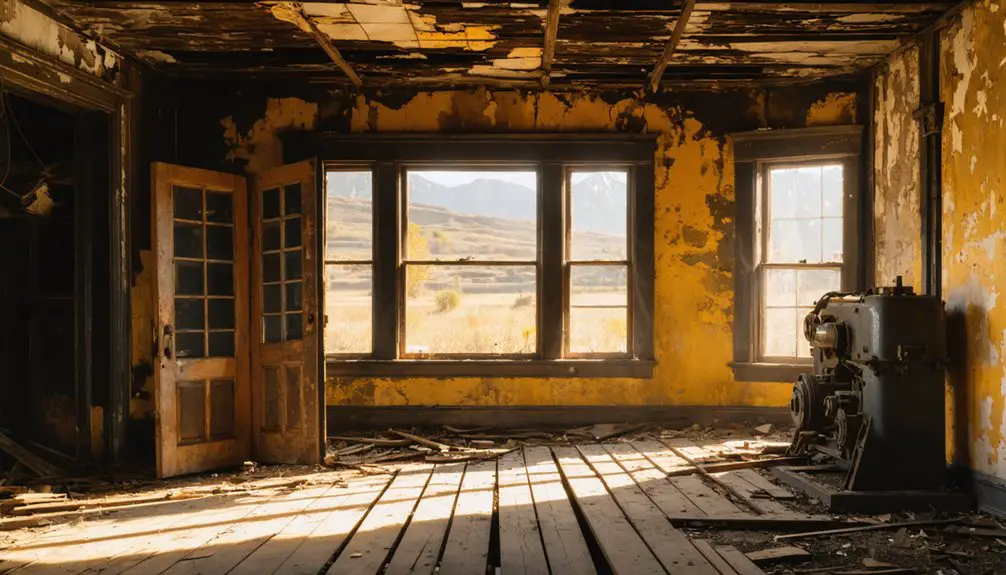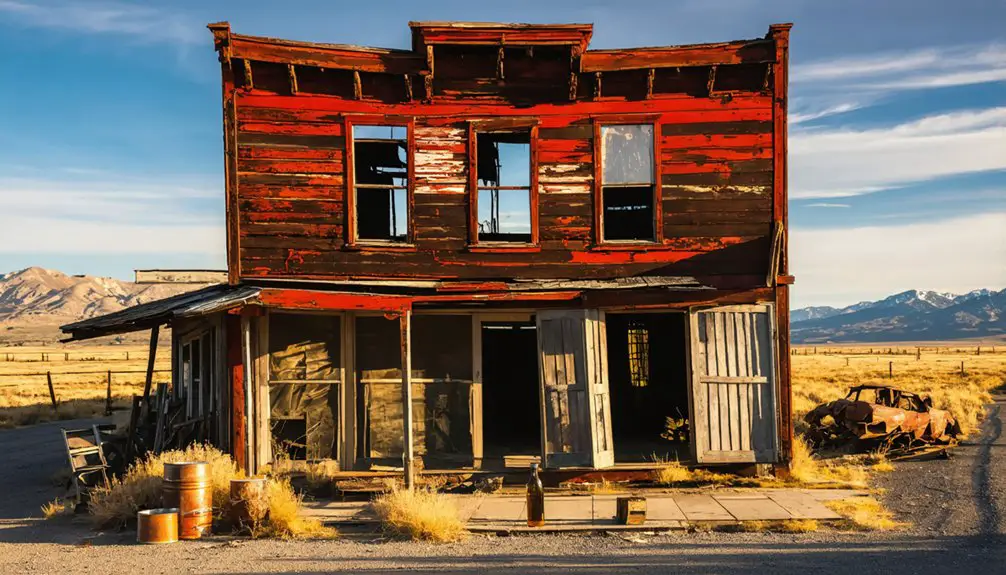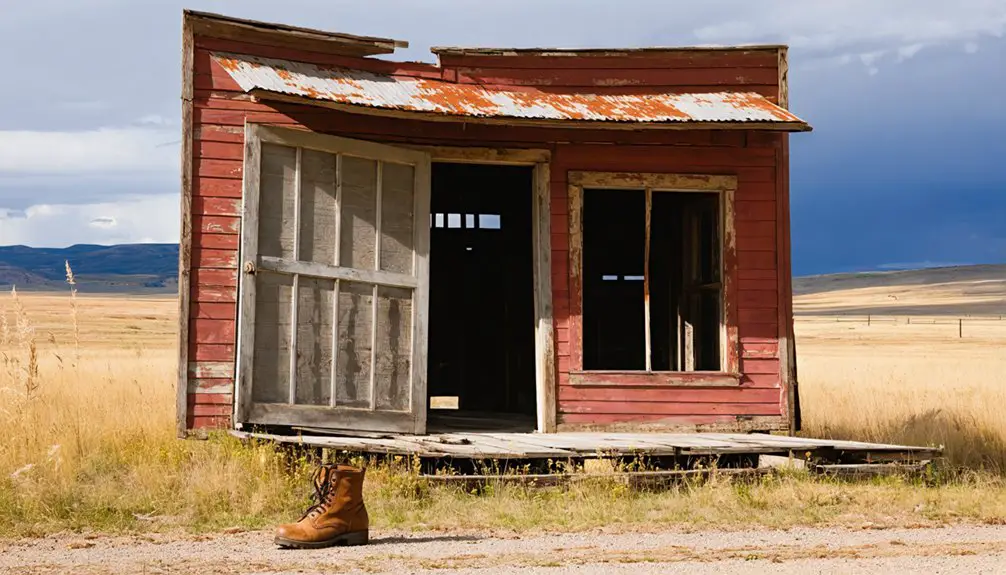You’ll find Ruby nestled in southern Arizona’s borderlands, where it began as Montana Camp in the 1870s before becoming one of the Southwest’s most productive mining settlements. During its 1930s peak, the town produced significant quantities of lead and zinc while supporting up to 2,000 residents with modern amenities. Though abandoned by 1941, Ruby’s well-preserved ruins, including the Montana Mine’s sealed shafts, still whisper fascinating tales of frontier life and notorious crimes.
Key Takeaways
- Originally named Montana Camp in the 1870s, Ruby became Arizona’s largest producer of lead and zinc from 1935-1939.
- The town peaked with 2,000 residents and modern amenities, supported by the Montana Mine’s processing of 870,000 tons of ore.
- Daily mining operations employed 350 workers across three shifts, utilizing a $100,000 pipeline for water supply until 1940.
- The community featured a schoolhouse serving 150 children, organized sports, and social activities centered around the pool hall.
- Ruby’s decline began after 1940, with the post office closing in 1941 and the site now preserved as a historic ghost town.
The Birth of a Mining Town

Although Spanish explorers had long known about mineral deposits in the area, significant mining activity in Ruby didn’t begin until after the Gadsden Purchase.
You’ll find the real story starting in the post-Civil War era when prospectors flocked to the Oro Blanco District, leading to the Montana Mine discovery in the 1870s.
The settlement began as Montana Camp, where miners faced economic challenges while testing various mining techniques in their search for gold, silver, lead, zinc, and copper.
Your early predecessors lived in simple cabins, shacks, and tents clustered around the mine site. The camp’s fortunes changed dramatically after 1891 when they discovered high-grade ore yielding 80-90 ounces of silver per ton.
This bonanza, coupled with the establishment of the Ruby Mercantile in the late 1880s, transformed the primitive camp into a growing mining community. Local prospectors discovered unique deposits similar to the raspberry color rubies found in North Macedonia.
From Montana Camp to Ruby
While Montana Camp began modestly in 1877 as a collection of makeshift dwellings at the base of Montana Peak, its transformation into Ruby marked a pivotal shift from frontier outpost to established mining town.
From humble mining camp to thriving town, Montana Camp’s evolution into Ruby exemplified the American frontier’s transformation.
You’ll find the town’s mining heritage deeply rooted in the early 1900s, when George Cheyney’s general store first opened in 1903, setting the stage for future development.
The real turning point came in 1912 when Julius Andrews secured a post office, naming it after his wife, Lille B. Ruby Andrews.
As mining operations expanded with improved techniques, you’d have witnessed the camp’s evolution into a proper town, complete with a schoolhouse and jail.
Despite its remote location near the Mexican border bringing security challenges, Ruby’s population and prosperity continued to grow through the 1910s.
Peak Mining Years and Operations

You’ll find Ruby’s most remarkable mining achievements during 1935-1939, when it became Arizona’s largest producer of lead and zinc, processing around 870,000 tons of ore that yielded 126,500 ounces of gold, 4.6 million ounces of silver, and 31,000 tons of lead.
Like many early mining operations in Montana’s hard rock mining boom, the extraction methods required intensive underground work to access the rich mineral deposits.
The Montana Mine’s daily operations ran around the clock with 350 miners working three shifts, supported by a 400-ton capacity flotation mill system installed at Montana Mill in 1934.
A $100,000 pipeline, completed in 1930 from the Santa Cruz Valley to Ruby, provided essential water supply for the intensive mining operations that would continue until 1940.
Mining Production Records
During its operational years from 1901 to 1948, the Ruby Mine Group processed an impressive 870,000 tons of ore, yielding substantial quantities of precious and base metals.
The mining techniques focused primarily on underground operations, extracting ore that contained average grades of 3.5% lead and 3.5% zinc, along with 5 ounces of silver and 0.5 ounces of gold per ton.
The Ruby Silver Mine, a key producer in the group, demonstrated particularly rich ore processing results.
You’ll find its recorded grades were remarkably high, reaching 8.8% for lead and 4.4% for zinc.
The mine’s final production year in 1948 maintained strong silver yields at 5 ounces per ton.
These impressive numbers reflect the region’s significance in Montana’s mining heritage and its contribution to America’s metal production during both World Wars.
The Ruby Creek Mine operations were thoroughly documented through U.S. Treasury reports detailing gold production between 1935 and 1938.
Montana Mine Daily Operations
At the height of Ruby’s mining operations in 1935, approximately 350 miners worked around the clock in three eight-hour shifts, seven days a week.
Using conventional mining techniques, workers extracted ore from multiple underground shafts and drifts, reaching depths of 750 feet via vertical hoists. The Montana Mine emerged as the state’s leading producer of lead and zinc between 1934-1937.
- Underground operations spanned over 4,000 feet of adits across three levels
- Daily ore shipments traveled 35 miles by truck to Amado for rail transport
- A $100,000 pipeline system supported essential water and material movement
- Skilled mill mechanics maintained continuous ore processing operations
You’d find miners operating under strict company control, with management overseeing both mining operations and social aspects of daily life in the company town of 2,000 residents.
Daily Life in a Frontier Community
In Ruby’s heyday, you’d find miners working long shifts extracting silver, lead, and zinc while contending with harsh conditions and limited water access.
You’d notice residents taking extensive safety precautions against border violence, with store owners and families keeping weapons close at hand for protection.
Despite the dangers, you’d see the community coming together for baseball games and rifle team competitions, creating moments of normalcy in this remote frontier town.
Miners’ Daily Work Routines
Life as a miner in Ruby’s Montana Mine meant enduring grueling 10-12 hour shifts of backbreaking labor with minimal safety protections.
You’d spend your days mastering essential mining techniques like drilling, blasting, and shoveling ore, while constantly watching for cave-ins and toxic dust exposure. The labor challenges were intense, requiring physical stamina to operate pickaxes, shovels, and early mechanical equipment.
- Operating heavy machinery and maintaining equipment for ideal ore processing
- Supporting mine shaft structures to prevent deadly cave-ins
- Managing tailings and waste material after primary extraction
- Coordinating with other workers to transport ore from extraction points to processing areas
Despite the introduction of improved machinery in the 1930s, you’d still face dangerous conditions and physically demanding work that tested your endurance daily.
Community Safety Measures
While Ruby’s remote location near the Mexican border offered opportunities for mining wealth, it also exposed residents to constant security threats that shaped daily routines. You’d find firearms strategically placed throughout homes and businesses, with store owners keeping weapons in every room.
The community’s defensive measures included fortified buildings and protected infrastructure, like the crucial 16-mile water pipeline and telephone lines.
Community vigilance was essential for survival. You’d see neighbors sharing information about suspicious individuals, while lawmen and citizens worked together to track raiders through footprints and cattle trails.
A monthly visiting judge held court in the bullet-scarred courthouse, though maintaining order proved challenging. Despite the dangers, the town sustained key institutions, including a school system and jail, demonstrating their commitment to preserving social order.
Social Life and Recreation
Despite its remote location and security challenges, Ruby maintained a vibrant social life centered around its schoolhouse, which served over 150 children during the town’s peak in 1936.
You’d find community gatherings regularly held in this central hub, where youth activities and social events brought residents together. The town offered diverse recreational options that fostered camaraderie among its frontier inhabitants.
- The pool hall served as a popular spot where miners could unwind after their shifts.
- Baseball teams and rifle clubs provided organized sports for both youth and adults.
- The confectionery store became a social hub where residents gathered for treats and conversation.
- Music, dancing, and card games in boarding houses created lasting bonds among neighbors.
Crime and Violence on the Border
Through decades of limited law enforcement coverage and jurisdictional complexities, Montana’s border region near Ruby has grappled with heightened violent crime rates that surpass national averages.
You’ll find aggravated assaults dominating the statistics at 81.6% of violent offenses, while border crime flourishes due to sparse police presence, especially on tribal lands.
In these remote areas, violence prevention efforts struggle against overwhelming challenges – some tribal territories spanning 1.5 million acres have just one or two officers on patrol.
Drug trafficking networks exploit these jurisdictional gaps, leading to increased criminal activity across the region.
The combination of limited resources, rural poverty, and complex multi-jurisdictional dynamics creates persistent safety concerns, particularly affecting Indigenous communities who face disproportionate impacts from these systemic challenges.
The Montana Mine Legacy

Beyond the border security challenges, Ruby’s rich mining heritage stands as a symbol of Montana’s industrial past.
The Montana Mine’s economic influence peaked between 1934-1937, when it became Arizona’s leading lead and zinc producer. Under Eagle-Picher Mining Company’s operation, the mine processed 870,000 tons of ore, yielding impressive quantities of precious metals valued at seven million dollars.
- Daily operations employed 325 workers across three shifts
- Advanced infrastructure included a $100,000 water pipeline
- Ore processing yielded 126,500 ounces of gold and 4.6 million ounces of silver
- Town supported up to 2,000 residents with modern amenities
Today, Ruby’s preserved buildings and mining equipment offer a glimpse into Arizona’s mining heritage, showcasing one of the best-maintained ghost towns in the region, though access remains restricted since June 2024.
The Final Days of Ruby
While Ruby’s mining operations had brought prosperity throughout the 1930s, the town’s decline accelerated rapidly after 1940 when ore production peaked and economic viability waned.
By 1941, you’d find the post office shuttered and community remnants fading away as residents departed, taking building materials with them. The final decline hit hard – the population plummeted from over 1,200 to virtually zero, leaving behind empty structures at the mercy of desert elements and vandals.
Though preservation efforts began in 1961 when Tucson residents purchased the site, Ruby’s transformation into a ghost town was complete.
Today, you can still visit the jail, schoolhouse, and mining structures that earned National Register status in 1975, though they continue deteriorating despite protection efforts.
A Ghost Town’s Silent Stories

As you walk through Ruby’s weathered streets today, each crumbling structure whispers tales of the town’s vibrant past. The ghostly whispers of untold histories linger in the preserved jail, schoolhouse, and playground where 1,200 residents once lived and worked.
You’ll discover a community that thrived on mining wealth, producing millions in precious metals between 1909 and 1949.
- The Montana Mine’s sealed shafts hold secrets of Arizona’s leading lead and zinc production
- Baseball games and rifle competitions once brought the community together
- Three notorious double homicides sparked the Southwest’s largest manhunt
- Families lived in everything from canvas tents to proper homes as the town grew
These silent structures, now listed in the National Register of Historic Places, stand as proof of Ruby’s remarkable frontier spirit.
Frequently Asked Questions
Are There Any Paranormal Activities Reported in Ruby’s Abandoned Buildings?
You’ll encounter ghost sightings and eerie sounds in Ruby’s desolate structures, including phantom piano music, unexplained footsteps, shadowy figures in windows, and mysterious voices echoing through abandoned tunnels beneath buildings.
What Happened to the Mining Equipment and Machinery After the Closure?
Like an abandoned Netflix set, you’ll find most equipment stayed put. The mill moved to Sahuarita, Arizona, but other mining relics preservation remained intact within private property, with minimal equipment restoration efforts attempted.
Can Visitors Take Artifacts or Minerals Found at the Ruby Site?
No, you can’t take artifacts or minerals – it’s illegal and violates preservation laws. The site’s private ownership and permit conditions strictly forbid artifact removal and mineral collection to protect historic integrity.
Were There Any Major Accidents or Disasters During Ruby’s Mining Operations?
Like a pristine page in history’s book, you won’t find records of major mining safety incidents or historical accidents at Ruby’s operations. The town’s dangers came from border conflicts, not mining disasters.
Where Did Most of Ruby’s Residents Relocate After the Town’s Abandonment?
You’ll find most Ruby residents relocated to nearby Tucson (70 miles northeast) and Nogales (30 miles southeast), while others moved to Arivaca (12 miles north) or followed mining opportunities elsewhere in Arizona.
References
- https://www.gvrhc.org/Library/Ruby.pdf
- https://en.wikipedia.org/wiki/Ruby
- https://www.scott-sports.com/us/en/page/gravel-tripping-ghost-town-ruby
- https://www.legendsofamerica.com/az-ruby/
- https://www.desertmountaineer.com/2023/03/04/ruby/
- https://parks.wa.gov/about/news-center/field-guide-blog/old-ruby-state-park-heritage-site-history
- https://www.ringbrothershistory.com/wp-content/uploads/2024/12/2002-Presentation-Al-Ring.pdf
- https://mhs.mt.gov/education/textbook/chapter6/Chapter6.pdf
- https://www.ringbrothershistory.com/wp-content/uploads/2024/12/2002-Ruby-The-Montana-Mine-Becomes-Al-Ring.pdf
- https://archiveswest.orbiscascade.org/ark:80444/xv647063



